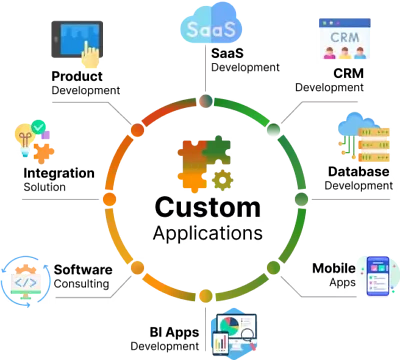Digital Identity Management with Blockchain: Enterprise Use Cases

In today’s hyper-connected world, digital identity management has become a cornerstone of secure enterprise operations. As cyber threats increase and regulations around data privacy tighten, organizations are searching for innovative, secure, and scalable ways to manage user identities. One of the most promising approaches emerging in recent years is leveraging blockchain technology. With the advent of enterprise blockchain solutions, digital identity management is undergoing a transformative shift.
What is Digital Identity Management?
- User authentication
- Access control
- Identity verification
- Credential storage
Enterprises often rely on centralized identity management systems, which, while functional, pose significant challenges including data breaches, identity theft, and lack of user control over personal data.
How Blockchain Enhances Digital Identity Management
- Decentralization: Eliminates single points of failure by distributing data across nodes.
- Immutability: Ensures that identity records cannot be altered retroactively.
- User Ownership: Empowers individuals to control their identity data.
- Interoperability: Supports cross-platform identity verification.
These features provide enterprises with more secure and efficient identity management solutions, reducing the risks associated with traditional systems.
Key Benefits of Blockchain for Enterprise Identity Management
1. Improved Security
- Encryption and decentralization reduce the risk of data breaches.
- Cryptographic keys ensure that only authorized users can access sensitive data.
2. Regulatory Compliance
- Helps meet global compliance standards like GDPR, HIPAA, and CCPA.
- Provides audit trails and data access logs for transparency.
3. Reduced Identity Fraud
- Verifiable credentials reduce the chances of fake identities.
- Instant verification lowers onboarding times and fraud risk.
4. Operational Efficiency
- Automates user authentication and credential management.
- Streamlines workflows across departments and systems.
Enterprise Use Cases of Blockchain in Identity Management
1. Employee Identity Verification
2. Customer Onboarding in Banking
3. Healthcare Identity Systems
4. Government and Public Services
5. Supply Chain Access Management
Companies in logistics and supply chains can manage vendor and partner access to systems and documents through decentralized identity credentials.
Choosing the Right Blockchain Software Development Company
Expertise in Blockchain Programming
Proven Track Record
Security Standards
The firm should follow best practices in encryption, access control, and data protection.
Customizable Solutions
Post-Deployment Support
Ongoing maintenance, updates, and scalability options should be available.
Blockchain Standards and Frameworks for Identity
- Decentralized Identifiers (DIDs): Globally unique identifiers stored on distributed ledgers.
- Verifiable Credentials (VCs): Digital attestations issued by trusted authorities.
- Hyperledger Indy: A blockchain framework specifically designed for decentralized identity.
- Sovrin Network: A public-permissioned blockchain for self-sovereign identity.
Challenges in Blockchain-Based Identity Management
- Scalability: Handling large volumes of identity data can strain network performance.
- Integration: Legacy systems may need upgrades to interact with blockchain platforms.
- User Education: Stakeholders must understand key management and decentralized identity principles.
- Regulatory Uncertainty: Varying laws across jurisdictions can complicate deployment.
The Future of Enterprise Blockchain Solutions in Identity
- Self-Sovereign Identity (SSI): Users gain full control over their digital identities.
- Biometric Integration: Combining blockchain with facial recognition, fingerprinting, etc.
- Cross-Border Identity Verification: Blockchain enables global interoperability.
- AI and Blockchain Synergy: Artificial Intelligence adds smart decision-making to identity management.
Industry-Specific Implementations of Blockchain Identity Management
Financial Services
- Example Use Case: A consortium of banks can use a shared blockchain ledger to verify customer identities once and reuse those credentials across institutions, reducing onboarding time and cost.
- Benefits: Real-time KYC updates, fraud prevention, and faster cross-border transactions.
Higher Education
- Example Use Case: Universities create verifiable credentials for graduates that hiring companies can instantly validate via a decentralized platform.
- Benefits: Simplified recruitment, reduced administrative overhead, and enhanced data integrity.
E-Commerce and Digital Platforms
- Example Use Case: E-commerce platforms implement decentralized login mechanisms, allowing users to authenticate via a blockchain identity wallet.
- Benefits: Enhanced user trust, fewer account hacks, and personalized user experiences.
The Rise of Decentralized Identity Wallets
Key Features:
- Self-custody: Users control their credentials, reducing reliance on third-party databases.
- Selective Disclosure: Share only necessary information (e.g., age but not full birthdate).
- Interoperability: Compatible across platforms using W3C standards like DIDs and VCs.
- Multi-factor Authentication (MFA): Combine biometrics, PINs, or devices for added security.
For enterprises deploying these wallets, collaborating with a skilled blockchain software development company is crucial. The wallet must integrate seamlessly into existing systems while preserving data privacy and regulatory compliance.
Implementing Blockchain Identity in Enterprises: A Strategic Roadmap
Transitioning from centralized identity systems to decentralized blockchain-based models requires a thoughtful, phased approach. Here’s a recommended roadmap to guide organizations through the process.
1. Conduct a Feasibility Study
2. Choose the Right Blockchain Development Service
3. Design the Identity Architecture
Define roles, permissions, and data flows. Use frameworks like Hyperledger Indy or Ethereum-based solutions to build smart contracts that govern identity issuance and verification.
4. Run a Pilot Project
5. Educate Stakeholders
Successful adoption depends on buy-in from users and administrators. Provide training on managing decentralized identities, securing keys, and using identity wallets effectively.
6. Scale and Optimize
Based on pilot outcomes, refine the system, enhance performance, and roll it out to other departments, regions, or business units. Continuously monitor for compliance and security updates.
Building Trust in a Decentralized Identity Ecosystem
- Standardization: Adhere to global standards like W3C DIDs and VCs for universal compatibility.
- Governance Models: Define clear rules around identity issuance, revocation, and dispute resolution.
- Third-Party Validation: Work with trusted issuers (e.g., banks, universities) to provide verified credentials.
- Continuous Auditing: Use automated logging and auditing features to ensure accountability and transparency.
Final Thoughts
Digital identity management is at a turning point. Traditional models, reliant on centralized databases and manual verification, are no longer sufficient in a world demanding speed, privacy, and security. Blockchain offers a powerful alternative that aligns with modern enterprise needs.
Investing in blockchain for identity management is not just a technological upgrade; it’s a strategic move toward a more secure, user-centric, and future-ready enterprise.Secure your enterprise’s future with blockchain-based identity management. Partner with a trusted blockchain software development company to build scalable, secure digital identity solutions.


